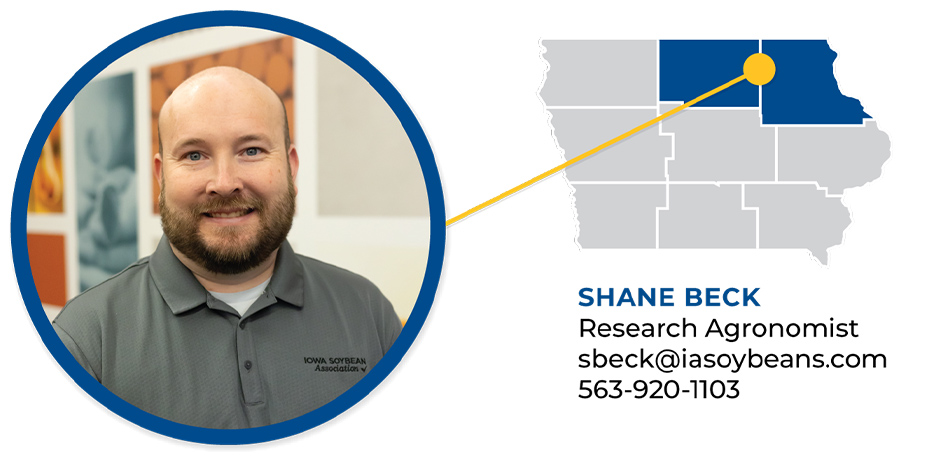
Walking soybean fields this year, it doesn’t take long to find four-bean pods, and disease pressure has been light aside from sudden death syndrome. (Photo: Iowa Soybean Association / Alex Schaffer)
Walking Rows: Scouting for white mold
August 28, 2025 | Kriss Nelson
Iowa Soybean Association (ISA) research agronomists continue to warn farmers of the effects sudden death syndrome (SDS) and white mold in soybeans and southern rust in corn could be having on yields. Farmers are encouraged to continue scouting for these diseases and make note of potential harm they have caused for future management decisions.
Reach out to your local research agronomist now to join fall trials and plan for the 2026 crop.
Alex Schaffer - Central/South Central Iowa
In central and southern Iowa, soybeans are reaching the full pod R6 stage and corn is denting at R5.
As I walk bean fields this year it doesn't take me long to find four bean pods and surprisingly haven't seen much disease pressure besides sudden death syndrome (SDS).
In my travels around the state, I see a lot of cornfields turning pretty yellow for the end of August. I attribute a lot of this to southern rust in fields that weren't treated with a fungicide. I believe the corn harvest will come early this year, as it seems to be turning dry and disease has done some damage, and the soybeans will be right on pace for average timing except where there are severe instances of SDS.

What I'm thinking about on the farm this time of year is aerially applying cover crops if that is part of your normal operation, booking fall anhydrous, getting harvest equipment ready and finalizing any other fall inputs.
ISA’s Research Center for Farming Innovation is currently recruiting for a trial that will explore the different sources of phosphorus fertilizer in strip-till. We are comparing an enhanced-efficiency phosphorus fertilizer with traditional MAP or DAP to identify cost savings considering the current economic climate of low commodity prices and high fertilizer costs.
Learn more about current trial opportunities here or contact your ISA research agronomist by emailing agronomy@iasoybeans.com.
Shane Beck – Northeast/Northern Iowa
Harvest is quickly approaching. Overall, the corn and soybeans appear to be in good condition, despite a fair amount of disease that is popping up in both crops.
I have seen and received several calls about sudden death syndrome (SDS) and how it's progressing in fields. Disease pressure has been variable from slight to heavy.
The cornfields are presenting more diseases now that the fungicide residual has expired. Southern corn rust is slowly taking over the fields, but at this point the corn is far enough along that there is not really a need to respray.

Fall trial recruitment is also in full swing, with five trials planned this season. We are recruiting for a trial on improved cropping systems, which examines how tillage, nitrogen inhibitors, and cover crops affect yield and soil health. Another trial involves a residual study testing the impact of applying a product called Meltdown by BW Fusion on corn stalks. We conduct several residue and soil samples to compare nutrient levels in treated versus untreated strips. The third trial involves a strip till experiment with Rhizosorb, a phosphorus product by Phospholutions, comparing it to MAP/DAP and evaluating strip till in both corn and soybeans. We are also partnering with Pivot Bio to test their new product, G3, assessing its performance at different rates of fall-applied anhydrous and variable rate nitrogen in strips, with and without G3 applied to the seed. The final trial we are recruiting for this fall is a smaller, five-rate nitrogen trial on five to 10 acres, in collaboration with the Iowa Nitrogen Initiative, to help determine optimal nitrogen rates using variable rate technology.
Mikaela Connelly - Southwest/West Central Iowa
Soybeans are pushing R6 (full seed), but some fields are still R5 (beginning seed). Over the last week, I’ve also seen quite a few diseases in soybeans, which were SDS, white mold, and minimal frogeye and brown spot. Unfortunately, it is too late in the growing season to do much for these diseases, but it is good to note for next growing season. Seed treatments really made a difference this year because SDS evolves from early-season disease presence, so I would say this is something that can be taken into the next growing season. If you applied a fungicide in corn or soybeans, it would be good to note the timing you used and the growth stage as it could help correlate application timing with disease presence as well as ROI with the applications.

Corn is at the R5 (dent stage) and will continue to dry down as we enter September. As previous Walking Rows segments mentioned, disease hit corn hard this year. I think the presence of the disease this year could make harvest start earlier and wrap up quickly.
As harvest season quickly approaches, now is a good time to do any maintenance on equipment and think about cover crop species selection and applications. It’s also a good time to think about nitrogen and/or dry fertilizer applications.
Having a soil sampling schedule for your operation is also helpful. I advise grid sampling every two to four years. Typically, this is done in the fall after harvest or in the spring before fieldwork, and in an ideal scenario, the sampling would be done prior to any fertilizer applications to help dial in the application rates for your fields.
Craig Woods – Northwest Iowa
Soybeans are progressing toward maturity, with most soybeans continuing or wrapping up pod fill, and will start the process of maturing soon. SDS and white mold continue to be the largest stress on maturing plants; however, overall pressure remains spotty throughout most fields I have scouted.
In corn, southern rust continues to have heavy pressure throughout the state, and northwest Iowa is no exception.
With harvest moving ever closer, now is a good time to look at your cover crop plan. The earliest window being inter-seeding with drone or plane to take advantage of heat units and readily available moisture to improve germination.

Now is also a good opportunity to look at areas that have experienced heavy weed pressure throughout the season, possibly because of previous drowned out or areas that have had a large seed bank in previous seasons. Taking photos for reference can help in evaluating the effectiveness of herbicide applications.
While scouting, getting yield estimates and determining the amount of lodging, if any, may be beneficial during harvest, especially if everything dries down as fast as it did last year.
Lucas De Bruin - Southeast/Eastern Iowa
Fall is approaching fast, and chopping has begun in southeast Iowa, allowing an initial look into cornfields. I can also confirm that corn harvest has begun, as I talked to a farmer who started picking corn on Friday. Southern rust has exploded even in fields with a fungicide application. It is definitely taking the top-end yield off.
The Pro Farmer Crop Tour results are in and soybean and corn yield estimates are up from last year. The potential is there, for sure, for soybeans, but the weather in the next month will really determine the final number.

Field days are wrapping up, and the team continues to scout plots and collect management data for our 2025 trials. From what I have seen so far, diseases are there in corn, even when fungicide was applied, but the soybeans are looking good and clean so far.
What concerns me the most with the soybeans is the height I have seen. There are a lot of tall soybeans that could become very short and flat if the right storm comes through. Let’s hope that doesn’t happen.
With all the moisture and excellent disease weather also means conducive conditions for early seeding of cover crops. Drones around southeast Iowa have applied cover crops into standing corn this past week.
We are recruiting for 2026 trials and planning for their fall implementation. Learn more about current trial opportunities here or contact your ISA research agronomist by emailing agronomy@iasoybeans.com.
Gathered by Kriss Nelson.
Back